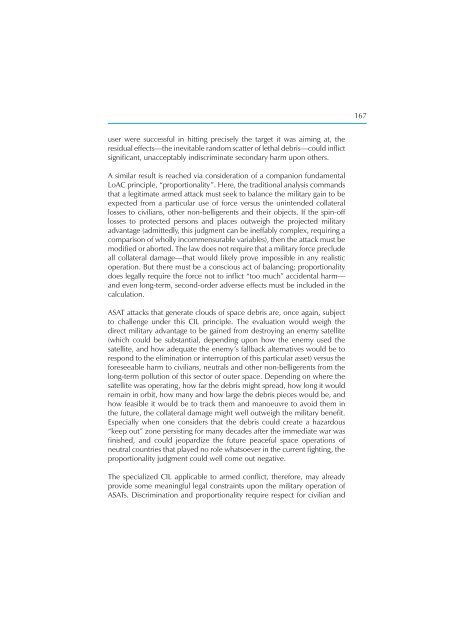Security in Space The Next Generation - UNIDIR
Security in Space The Next Generation - UNIDIR
Security in Space The Next Generation - UNIDIR
Create successful ePaper yourself
Turn your PDF publications into a flip-book with our unique Google optimized e-Paper software.
user were successful <strong>in</strong> hitt<strong>in</strong>g precisely the target it was aim<strong>in</strong>g at, the<br />
residual effects—the <strong>in</strong>evitable random scatter of lethal debris—could <strong>in</strong>fl ict<br />
signifi cant, unacceptably <strong>in</strong>discrim<strong>in</strong>ate secondary harm upon others.<br />
A similar result is reached via consideration of a companion fundamental<br />
LoAC pr<strong>in</strong>ciple, “proportionality”. Here, the traditional analysis commands<br />
that a legitimate armed attack must seek to balance the military ga<strong>in</strong> to be<br />
expected from a particular use of force versus the un<strong>in</strong>tended collateral<br />
losses to civilians, other non-belligerents and their objects. If the sp<strong>in</strong>-off<br />
losses to protected persons and places outweigh the projected military<br />
advantage (admittedly, this judgment can be <strong>in</strong>effably complex, requir<strong>in</strong>g a<br />
comparison of wholly <strong>in</strong>commensurable variables), then the attack must be<br />
modifi ed or aborted. <strong>The</strong> law does not require that a military force preclude<br />
all collateral damage—that would likely prove impossible <strong>in</strong> any realistic<br />
operation. But there must be a conscious act of balanc<strong>in</strong>g; proportionality<br />
does legally require the force not to <strong>in</strong>fl ict “too much” accidental harm—<br />
and even long-term, second-order adverse effects must be <strong>in</strong>cluded <strong>in</strong> the<br />
calculation.<br />
ASAT attacks that generate clouds of space debris are, once aga<strong>in</strong>, subject<br />
to challenge under this CIL pr<strong>in</strong>ciple. <strong>The</strong> evaluation would weigh the<br />
direct military advantage to be ga<strong>in</strong>ed from destroy<strong>in</strong>g an enemy satellite<br />
(which could be substantial, depend<strong>in</strong>g upon how the enemy used the<br />
satellite, and how adequate the enemy’s fallback alternatives would be to<br />
respond to the elim<strong>in</strong>ation or <strong>in</strong>terruption of this particular asset) versus the<br />
foreseeable harm to civilians, neutrals and other non-belligerents from the<br />
long-term pollution of this sector of outer space. Depend<strong>in</strong>g on where the<br />
satellite was operat<strong>in</strong>g, how far the debris might spread, how long it would<br />
rema<strong>in</strong> <strong>in</strong> orbit, how many and how large the debris pieces would be, and<br />
how feasible it would be to track them and manoeuvre to avoid them <strong>in</strong><br />
the future, the collateral damage might well outweigh the military benefi t.<br />
Especially when one considers that the debris could create a hazardous<br />
“keep out” zone persist<strong>in</strong>g for many decades after the immediate war was<br />
fi nished, and could jeopardize the future peaceful space operations of<br />
neutral countries that played no role whatsoever <strong>in</strong> the current fi ght<strong>in</strong>g, the<br />
proportionality judgment could well come out negative.<br />
<strong>The</strong> specialized CIL applicable to armed confl ict, therefore, may already<br />
provide some mean<strong>in</strong>gful legal constra<strong>in</strong>ts upon the military operation of<br />
ASATs. Discrim<strong>in</strong>ation and proportionality require respect for civilian and<br />
167








